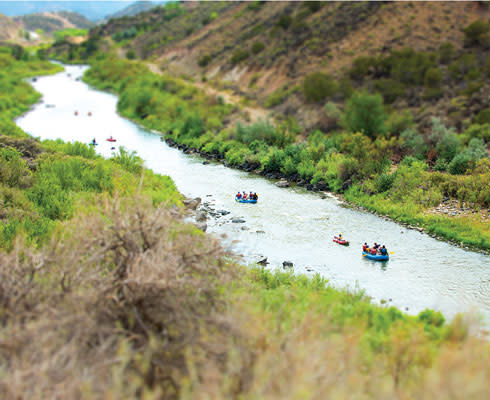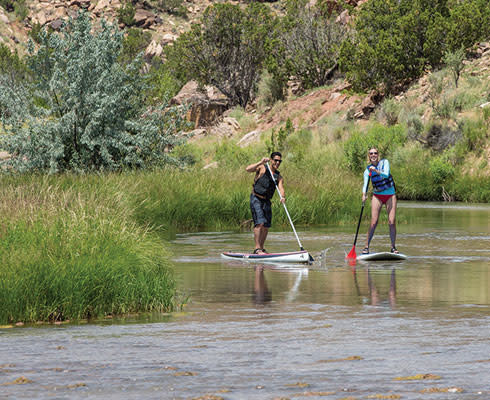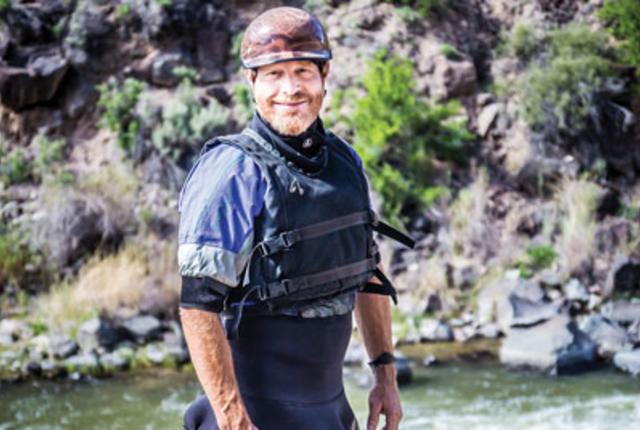Canada's Hay River flows east from British Columbia into the remote, glaciated Northwest Territories before surging into a deep gorge and spilling over two waterfalls. The second and larger of the falls, Alexandra, resembles a mini Niagara, with more than 30,000 gallons of water per second dropping 104 feet in a gushing torrent of whitewater. Surely one would have to be fearless, if not certifiably insane, to even contemplate hurtling off such a cataract in a small plastic boat. But that’s exactly what New Mexican Ed Lucero did in 2003. No one had ever paddled off something so hugely ridiculous and lived to talk about it.
The pioneer of extreme whitewater kayaking in New Mexico recounts the experience as a feat of total concentration. Lucero shoved into the river and bobbed toward the edge. He dug his paddle hard into the current, propelling himself forward. “My thought was that I wanted to kinda fold forward so that all my weight would be in the front of the boat. I would be like an arrow,” Lucero recalls. With a film crew in place and the roar of the falls growing deafening, Lucero slipped over the edge and disappeared into the mist.
Now 48, “Crazy Ed” is still compact and strong, with a shock of curly red hair crowning a sun-baked face. Born and raised in New Mexico, Lucero became one of the biggest names in whitewater kayaking as the sport peaked in the nineties and early aughts. He toured all over the world, thrilling boat-festival crowds with skills honed in the Land of Enchantment. This was the same time that innovations in kayak design were ushering in new tricks and radical runs on plummeting waterways, and a tangent of the sport dubbed steepcreeking took off. Lucero was a big part of it, and he opened up many whitewater routes in the Southwest. These days, he’s still out there.
Lucero did not begin kayaking until his early twenties, but he always loved the outdoors. He spent his childhood playing in the wilderness near Cimarrón, where his grandparents lived, and in White Rock, where he largely grew up. Lucero skied, hiked, canyoneered, and generally took outrageous risks as a youth. On one occasion he attempted to float on an inner tube on a very dry Lewis Lake, near Cimarrón. The lake was so dry he ended up nearly drowning in a sort of quicksand. Only the inner tube kept him above the mire. “I remember everyone being so afraid, but I was like, ‘It’s no big deal,’” Lucero recalls. “I would say I have more than nine lives, definitely.”
He started paddling much later, after a four-year stint in the Navy, where he worked as a hull technician, helping weld and repair the fast frigates used for chasing Russian submarines. With his final $600 check from the government, he purchased a plastic kayak, helmet, and personal flotation device through a classified ad. Lucero had no idea what he was doing, but he found that he was adept at the sport and wanted to get better. He started practicing in the Albuquerque canals. “I was definitely the only guy playing in the ditch,” he says.
One day, while haphazardly practicing the kayak roll—a full rotation above and below the surface, like a log—in the Albuquerque canals, Lucero drew the attention of a more experienced kayaker who invited him to a local class. He mastered the fundamentals quickly, and soon he was paddling the Río Grande.
Kayaking became the dominant passion in his life. For a time, Lucero kept a job in Albuquerque as a jewelry fabricator, utilizing some of the welding and metalworking skills he learned in the Navy to produce turquoise-inlaid wearables for a growing market. But he was about to become much better known for his abilities on the water.
Larry Hays, a friend and paddling mentor, wrote a profile of Lucero in a 1994 American Whitewater newsletter. Hays described Lucero as a “hairboater”— a death-defying kayaker who braved narrow rivers in high water. “Ed kept improving at the same incredible rate and soon passed me by. He ran Pine Creek, and after it failed to kill him two or three times, I finally got on it at low water,” wrote Hays.
Lucero notched first descents on the Upper Canyon of the Brazos, the Guadalupe, and what he called the “Upper Ditch” of Albuquerque. “I just felt like I could do stuff that people hadn’t done,” he says. And, although friends called him a lunatic, he kept searching for bigger, wilder whitewater. Lucero found the sport at the right time. Smaller, flat-bottomed boats had appeared on the market, designed specifically for surfing the river, performing tricks, and navigating obstacles. Suddenly, previously unrunnable rivers could be managed. Kayakers became the poster children for extreme sports as they paddled more and more difficult runs and launched off ever taller waterfalls.
The new kayaking also attracted big money and big crowds. Kayak rodeos that spotlighted races and bold new tricks became popular events. At one such rally, in Durango, Lucero caught the attention of Colorado-based boat manufacturer Wave Sport, which offered him a sponsorship.
Lucero began traveling the world to run new rivers. Filmmakers tagged along, too, and soon he was the star of extreme sports films, shot on location in places like Ecuador and Costa Rica. In the United States, he lived out of an RV, towing a plywood trailer, pulling together enough money from his sponsors and the odd construction job. After breaking some ribs when running Casanova Falls in Ecuador in 1996, he designed a specialty vest for the boating-jacket manufacturer Stohlquist. It allowed for easier rescue and a safer upper body.
But it was the short, dramatic trip down Alexandra Falls that made Lucero famous. A kayak expedition Lucero took with some friends spawned the idea. “I went up to the Slave River. I was planning to go kayaking and surf some waves. I didn’t even know the waterfall was there,” he explains. “I was like, ‘Wow, there’s a line through there.’”
“The place is so big that it makes you seem insignificant,” Lucero continues. “You run these big waves, and something that looks like it would trap you and keep you for thousands of years just flushes you right out.”
Lucero was superfit. He’d recently towed his kayak gear behind a bicycle, pedaling 1,300 miles from Sandpoint, Idaho, to New Mexico. While in Canada, it just took a little practice in these fast-flowing rivers to give him the confidence he needed to attempt Alexandra.
A week after first spotting it, Lucero returned to the falls with a film crew. If necessary, they could haul him out of the gorge on a stretcher. But none of that was in Lucero’s mind when he started paddling toward the drop. “I was not anxious at that point. I just had total tunnel vision, looking at where I had to go,” he recalls.
“You’re a hurdler and you’re jogging towards it,” Lucero says of the edge. He tried to push up and forward in the small kayak. “This was kind of an unknown thing, what your body position should be.” If he was wrong and out of alignment, a strong gust of wind could have pushed him off course. But he rolled smoothly over the edge.
“I think it’s like a three-second fall. That pause—tucking forward and waiting—felt like a long time,” he says. “I don’t remember hearing anything, and it doesn’t really feel like you’re falling. It definitely seems like a calm space. I’m tucking up and holding my breath.”
The tiny red kayak vanished into the tumbling cascade, then “Bam! I take the biggest hit I’ve had in my life,” he says. “It was enough for me to hear a tone like getting your bell rung.”
Pain erupted in his leg and he popped out of his boat, concerned that his leg could be broken. He’d been under for four suspenseful seconds, but then his crew spotted him on the surface. Lucero swam to shore and checked himself for injury. Amazingly, he was unharmed. The next day, however, the impact caught up with him. “When I woke up, I could barely walk. It was the most pain I’ve ever been in,” he says. “I got what I wanted, but I also got what I deserved.”
Lucero had cemented his name in paddling history, but he dialed it back after that, spending the next few years helping develop an affordable cargo bike in Kenya and paddling only periodically. “My challenges are less about new runs and wild waterfalls, more about nailing my best lines and the never-ending new styles of river surfing. Nothing compares to enjoying a river with friends. The challenge of higher waterfalls is history,” Lucero has written.
Lucero returned to New Mexico in 2006. He and his wife, Erika, have two children, Rio and Geo. It’s no accident that the Luceros make their home just feet from the Río Grande, in Embudo. Lucero continues to crusade for river access, he’s building a kayaker’s hostel on his property, and he’s been working to establish a dedicated play spot in Española—sort of a skate park for kayakers.
Once the spring hits, you can find Lucero back on the water. Whether playing in Pilar on the Río Grande or on the Chama, he appreciates what the state has to offer.
“We’re so lucky in New Mexico to have that kind of experience here,” Lucero says. “People can spend thousands of dollars on the Grand Canyon, or you can go down the Chama for free.”
Among other pursuits, Jason Strykowski has worked as an outdoor adventure guide here in New Mexico.
--------
PADDLING NM:
Plenty of Rivers Run Through It
The Río Grande, the Chama, and the Gila all support rafting, stand-up paddling, tubing, and kayaking. Some of the runs listed here require a guide. Average weekend adventurers can attempt others, as long as they take proper safety precautions.
Flow rates vary seasonally and yearly, so check on both water and wilderness conditions before you go. Flow rate is given in cubic feet per second (cfs). Generally, whitewater is graded on the International Scale of River Difficulty. Class I is the least difficult, featuring mainly flat water. Class V, at the other end of the spectrum, may include drops, large waves, and other technical challenges.
Boaters should check ahead on applicable charges and permits before departing. A handful of New Mexico companies also offer fully guided trips down several of these rivers.
 A mellow section of the Río Grande three miles south of the Pilar put-in.
A mellow section of the Río Grande three miles south of the Pilar put-in.
The Upper Taos Box
PUT-IN: Chiflo Trail: From Questa, take NM 522 north and NM 378 west
TAKE-OUT: Little Arsenic
RATING: V and above
SEASON: Spring through summer
FOR MORE INFORMATION: mynm.us/uppertaosbox
The Box is a rollicking and treacherous feature on the Upper Río Grande, and perhaps the most iconic stretch of whitewater in New Mexico. Situated north of Taos in the Río Grande Gorge, the Box encompasses some 100 miles of river but is generally split into two runnable sections. The more difficult of the two, the Upper Box is for experts only and is filled with hazardous obstructions and features like boulders and eddies. Once started, the Upper Box cannot be exited except by attempting to climb out of the gorge.
--------
The Lower Taos Box
PUT-IN: John Dunn Bridge: Take CR B-007 from NM 522 north of Taos
TAKE-OUT: Taos Junction Bridge
RATING: III to IV
SEASON: All year
FOR MORE INFORMATION: mynm.us/lowertaosbox
Less difficult and more crowded than its northern neighbor, the Lower Box has easier access than the Upper but offers plenty of fast water and great views as it carves through the Gorge. Many boaters on this section will paddle with commercial rafting outfitters. However, the stretch makes a great alternative to the Upper Box for those in kayaks and canoes. In very low water, the Lower Box can become more technical and should not be attempted.
--------
The Racecourse
PUT-IN: Quartzite, near Pilar off NM 68
TAKE-OUT: County Line
RATING: III to IV
SEASON: All year
FOR MORE INFORMATION: mynm.us/theracecourse
Legions of rafters enjoy the Racecourse every spring. In high-flow season, this more southerly sibling of the Boxes is also on a tamer part of the Río Grande. In dry years, the Racecourse makes the perfect spot for running the river solo in inflatable kayaks or stand-up paddleboards, which can be rented at a number of local retailers. Much of this part of the river is visible from NM 68 on the way to Taos and easily accessed from several pull-offs just feet from the highway.
 Paddleboarding on the Chama, just downriver from the Abiquiu Dam.
Paddleboarding on the Chama, just downriver from the Abiquiu Dam.
The Gila River
PUT-IN: Gila Cliff Dwellings Visitor Center: Take NM 15 north from Silver City
TAKE-OUT: Mogollon Creek
RATING: II to III
DISTANCE: 36 miles
SEASON: Early spring
MORE INFORMATION: mynm.us/gilakayak
Cutting through the Gila Wilderness Area, this run makes a great multi-day float for hardy souls interested in a challenging stretch of river. While the major local draw is the nearby historic Native American archaeology, this stretch of river is a floating museum filled with foliage and varied geology. Boaters can expect plentiful wildlife and dense forests, but not many other people through this mountainous and canyon-filled stretch. Low water levels most of the year and a multitude of rock outcroppings provide plenty of challenges and should dissuade novices from this option.
--------
Río Chama
PUT-IN: El Vado Ranch, on NM 112, off US 84 above Tierra Amarilla
TAKE-OUT: Big Eddy
RATING: II to III
DISTANCE: 31 miles
SEASON: Spring through fall
MORE INFORMATION: mynm.us/riochama
The Chama is a loaded experience that offers wildlife viewing, historic sites, fishing, and deep sandstone canyons. The river is so popular that the BLM has to monitor and control the number of floaters each season. Permits are assigned by lottery, and boaters are expected to be adequately packed and prepared for the multi-day trip. While on the river, boaters should bear left after Skull Bridge and expect the river to pick up speed and hit a series of rapids.
--------
The San Juan River
PUT-IN: Navajo Dam: Take US 64 from Bloomfield to NM 511
TAKE-OUT: Blanco
RATING: I to II
DISTANCE: 17 miles
SEASON: Spring through fall
MORE INFORMATION: mynm.us/sanjuanriver
A great spot for a lazy, multi-day float, this stretch can be paddled in canoes, kayaks, and rafts. From Navajo Dam, the river drifts slowly through Navajo Lake State Park, where paddlers will have to avoid other boaters and fishing lines, not rocks. Because the river can move slowly but flows year-round, this is also an ideal place to practice boating skills in relative safety. Minimal experience is necessary for the trip, but this stretch will reward floaters with plentiful wildlife and fishing in the state park.


